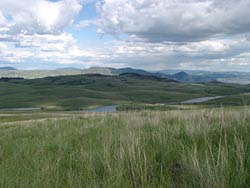
Chernozems are associated with grassland ecosystems such as Lac du Bois Range, north of Kamloops, BC
Chernozemic soils (or Mollisol in USDA Soil Taxonomy) have surface horizons darkened by organic matter accumulation. A chernozemic A horizon must be at least 10 cm thick and be dark in colour. They are generally found under grassland communities or grassland-forest communities with associated shrubs and forbs. The region dominated by Chernozemic soils has mean annual soil temperatures > 0°C but usually < 6°C and experiences water deficits in most growing seasons.
The four great groups of the Chernozemic order are based on the colour of the A horizon, which reflects the amount of organic matter present in the horizon.
Brown Chernozem Great Group
Soils of this great group have colour (dry) value 4.5 – 5.5 and chroma (dry) usually > 1.5; and occur in areas with mean annual water deficit of 19-38 cm.
Dark Brown Chernozem Great Group
Soils of this great group have colour (dry) value 3.5 – 4.5 and chroma (dry) usually > 1.5; and occur in areas with mean annual water deficit of 13-19 cm.
Black Chernozem Great Group
Soils of this great group have colour (dry) value <3.5 and chroma (dry) usually < 1.5; and occur in areas with mean annual water deficit of 6.5-13 cm.
Dark Gray Chernozem Great Group
Soils of this great group have colour (dry) value 3.5 – 4.5 and chroma (dry) usually < 1.5; and occur in areas with mean annual water deficit of 6.5-13 cm. The Dark Gray Chernozems are located in the transition zones between the grassland dominated soils and the forest soils, hence these soils show evidence of both grass and forest vegetation. The A horizon associated with Dark Gray Chernozem is typically an Ahe horizon.